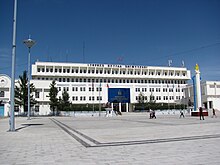Arwaicheer
|
Arvaikheer Арвайхээр |
||
| Country: |
|
|
| Aimag : | Öwörchangai | |
| Coordinates: | 46 ° 16 ' N , 102 ° 47' E | |
| Removal of UB | ||
| Beeline: | 364 km | |
| Residents: | 40,000 (2019, estimated) | |
| Time zone: | UTC + 8 | |
| Telephone code: | +976 (0) 132 | |
| License Plate: | ӨВ_ (_ variable) | |
| Community type: | Aimag center | |
|
|
||
Arwaicheer ( Mongolian Арвайхээр ) is the capital of the Mongolian province Öwörchangai in the center of the country. The city is a center for traditional arts, livestock and equestrian sports . The place is the scene of an annual regional horse festival. The city was named after a famous 18th century racehorse.
location and size
The city is almost exactly in the middle of Mongolia in the steppe 1913 m. ü. d. M., 430 km from the capital Ulaanbaatar . South of the city, the steppe vegetation slowly merges into the Gobi desert .
The population of Arwaicheer was 19,058 (2000 census), 23,298 (2004 est.), 24,200 (2006 est.). This makes Arwaicheer by far the largest town in the entire aimag.
traffic
Arwaicheer has an airport about 1 km south of the city with a 1.5 km long, unpaved runway. From here there are flights to the capital Ulan Bator .
Arwaicheer is also connected to the capital by an asphalt road with regular buses. Slopes lead to the north and south of the aimag.
Sights and infrastructure
Until 1990, Arwaicheer was the seat of a command of the Soviet Army, the presence of which had a significant impact on the city's architecture. In recent years, however, numerous public buildings have been renovated or rebuilt, such as B. the sports palace in the east of the city. Opposite a large park was also created, not far from it an amusement park for children was created. Another park is being built just west of the city center, which is associated with considerable difficulties in view of the dry climate - on average, only 254.2 mm of precipitation fall in the Aimag annually. In contrast to most cities in Mongolia, most of the residents of Arvaeheer do not live in yurts , but in solid buildings made of wood or stone.
The renovated building of the city administration is worth seeing on the central square of the city, opposite the also renovated modern city theater. To the south of the square runs the city's wide, tree-lined main street, on which two monuments from before 1990 are noteworthy. Otherwise, there is little to remind you of the time of the Mongolian People's Republic in Arvaicheer .
The relatively large Gandan Muntsaglan Khiid Monastery is about 1 km from the central square. It was destroyed in 1937 during the anti-Buddhist riots under the then head of state and party leader Chorloogiin Tschoibalsan and reopened in 1991. About 60 monks currently live here.
In Aimagmuseum include fossils and finds from Karakorum issued. Another museum in Arvaicheer is dedicated to one of the most important artists in Mongolia, the Lamaist monk Dsanabadsar .
As the capital of an aimag, Arvaicheer is the seat of various authorities. The city also has a large hospital, kindergartens and various schools and educational institutions. In the city center there are three hotels, an internet café, several restaurants and numerous shops, so that the shopping opportunities are good by Mongolian standards.
Web links
swell
- ^ My Life in Mongolia . WordPress. January 10, 2009. Retrieved August 8, 2014.
- ↑ Ministry of Health of Mongolia, National Center for Health Development, Health Indicators 2006, (PDF) ( Memento of the original from March 25, 2009 in the Internet Archive ) Info: The archive link has been inserted automatically and has not yet been checked. Please check the original and archive link according to the instructions and then remove this notice.
- ↑ Werner Elstner: Mongolei , p. 132. Berlin 1993.
- ^ Marion Wisotzki: Mongolei , p. 184. Berlin 2010
- ↑ Michael Kohn: Mongolia , p. 117. London 2008.
- ↑ Michael Kohn: Mongolia , p. 118. London 2008.




